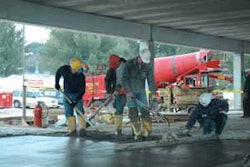The recent fervor over immigration reform has drawn attention to the high prevalence of immigrant labor employed in the construction industry. The U.S. Census Bureau's 2004 American Community Survey shows that approximately 20% of U.S. construction workers are foreign born. Of that number, 54% come from Mexico, 25% come from countries throughout the Americas, 12% are European and 8% are Asian ("Immigrant Workers in Construction", National Association of Home Builders).
Unfortunately, these workers also make up a disproportionate number of jobsite fatalities. For example, the U.S. Department of Labor notes that while Hispanic workers represent 18% of the construction workforce, they account for 21% of deaths on the job. And while fatalities among English-speaking workers has fallen, it continues to increase among non-English-speaking employees.
The difficulties in effectively communicating safety and other training materials, as well as the challenge in understanding cultural disparities among workers, can result in a potentially unsafe work environment. Effectively integrating foreign employees into your workforce requires an investment in training resources targeted to their specific needs. Such an investment can pay for itself quickly in the form of an improved safety rating, reduced insurance costs and enhanced worker productivity.
In the article "Best Practices in Training Hispanic Workers" (Occupational Hazards magazine, Electronic Library of Construction Occupational Safety and Health), James Nash offers the following advice about bilingual training.
When selecting a trainer, make sure the individual has an understanding of the construction industry and its terminology, and can effectively communicate his or her knowledge in the workers' native language. The trainer should also exhibit sensitivity to cultural and educational differences that could affect how workers process the information.
Educate workers on their rights in the workplace. Nash cites a tendency among some Hispanic workers to avoid the appearance of disagreeing with or challenging authority. This can place such workers at risk if they agree to do an unsafe job, or feel unable to stop a co-worker from risky behavior. Make sure workers understand they are entitled to a safe work site.
Altering ingrained cultural and work practices often requires longer-term (24 hour or more) training. At the conclusion of this training, it's critical to evaluate the workers' understanding to ensure the information has been adequately processed. Hands-on evaluations tend to be the most effective.
Of course, training doesn't stop once a program is completed. It's important to continually reinforce training via weekly safety meetings, additional hazard training, etc.
Experts also advise making training and safety materials available in multiple languages; using universal safety signs around jobsites; recruiting bilingual employees to assist in communications; and establishing a mentor or job shadow program with experienced bilingual workers in similar positions.
For additional insight and training materials for non-English-speaking workers, turn to OSHA's web site at www.osha.gov.



















